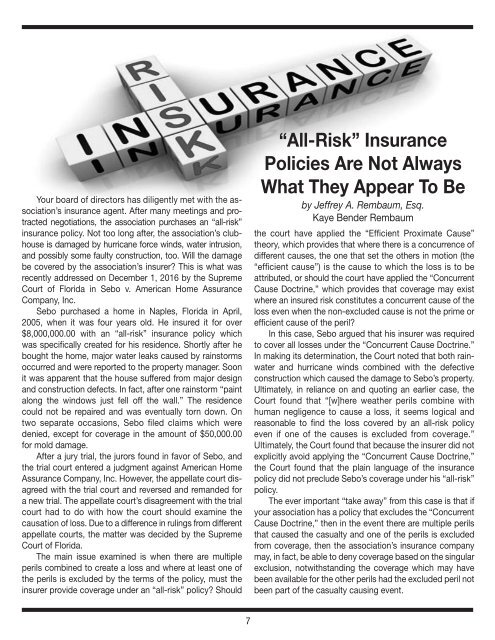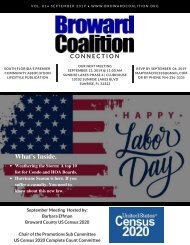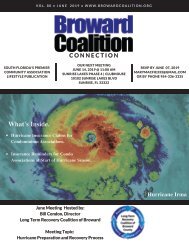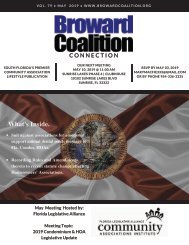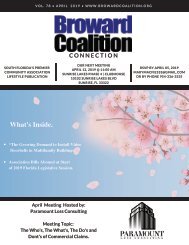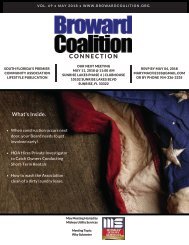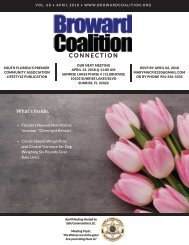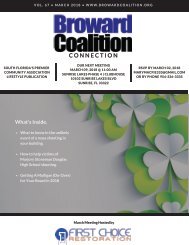June 2018 Newsletter
- No tags were found...
Create successful ePaper yourself
Turn your PDF publications into a flip-book with our unique Google optimized e-Paper software.
Your board of directors has diligently met with the association’s<br />
insurance agent. After many meetings and protracted<br />
negotiations, the association purchases an “all-risk”<br />
insurance policy. Not too long after, the association’s clubhouse<br />
is damaged by hurricane force winds, water intrusion,<br />
and possibly some faulty construction, too. Will the damage<br />
be covered by the association’s insurer? This is what was<br />
recently addressed on December 1, 2016 by the Supreme<br />
Court of Florida in Sebo v. American Home Assurance<br />
Company, Inc.<br />
Sebo purchased a home in Naples, Florida in April,<br />
2005, when it was four years old. He insured it for over<br />
$8,000,000.00 with an “all-risk” insurance policy which<br />
was specifically created for his residence. Shortly after he<br />
bought the home, major water leaks caused by rainstorms<br />
occurred and were reported to the property manager. Soon<br />
it was apparent that the house suffered from major design<br />
and construction defects. In fact, after one rainstorm “paint<br />
along the windows just fell off the wall.” The residence<br />
could not be repaired and was eventually torn down. On<br />
two separate occasions, Sebo filed claims which were<br />
denied, except for coverage in the amount of $50,000.00<br />
for mold damage.<br />
After a jury trial, the jurors found in favor of Sebo, and<br />
the trial court entered a judgment against American Home<br />
Assurance Company, Inc. However, the appellate court disagreed<br />
with the trial court and reversed and remanded for<br />
a new trial. The appellate court’s disagreement with the trial<br />
court had to do with how the court should examine the<br />
causation of loss. Due to a difference in rulings from different<br />
appellate courts, the matter was decided by the Supreme<br />
Court of Florida.<br />
The main issue examined is when there are multiple<br />
perils combined to create a loss and where at least one of<br />
the perils is excluded by the terms of the policy, must the<br />
insurer provide coverage under an “all-risk” policy? Should<br />
“All-Risk” Insurance<br />
Policies Are Not Always<br />
What They Appear To Be<br />
by Jeffrey A. Rembaum, Esq.<br />
Kaye Bender Rembaum<br />
the court have applied the “Efficient Proximate Cause”<br />
theory, which provides that where there is a concurrence of<br />
different causes, the one that set the others in motion (the<br />
“efficient cause”) is the cause to which the loss is to be<br />
attributed, or should the court have applied the “Concurrent<br />
Cause Doctrine,” which provides that coverage may exist<br />
where an insured risk constitutes a concurrent cause of the<br />
loss even when the non-excluded cause is not the prime or<br />
efficient cause of the peril?<br />
In this case, Sebo argued that his insurer was required<br />
to cover all losses under the “Concurrent Cause Doctrine.”<br />
In making its determination, the Court noted that both rainwater<br />
and hurricane winds combined with the defective<br />
construction which caused the damage to Sebo’s property.<br />
Ultimately, in reliance on and quoting an earlier case, the<br />
Court found that “[w]here weather perils combine with<br />
human negligence to cause a loss, it seems logical and<br />
reasonable to find the loss covered by an all-risk policy<br />
even if one of the causes is excluded from coverage.”<br />
Ultimately, the Court found that because the insurer did not<br />
explicitly avoid applying the “Concurrent Cause Doctrine,”<br />
the Court found that the plain language of the insurance<br />
policy did not preclude Sebo’s coverage under his “all-risk”<br />
policy.<br />
The ever important “take away” from this case is that if<br />
your association has a policy that excludes the “Concurrent<br />
Cause Doctrine,” then in the event there are multiple perils<br />
that caused the casualty and one of the perils is excluded<br />
from coverage, then the association’s insurance company<br />
may, in fact, be able to deny coverage based on the singular<br />
exclusion, notwithstanding the coverage which may have<br />
been available for the other perils had the excluded peril not<br />
been part of the casualty causing event.<br />
7


